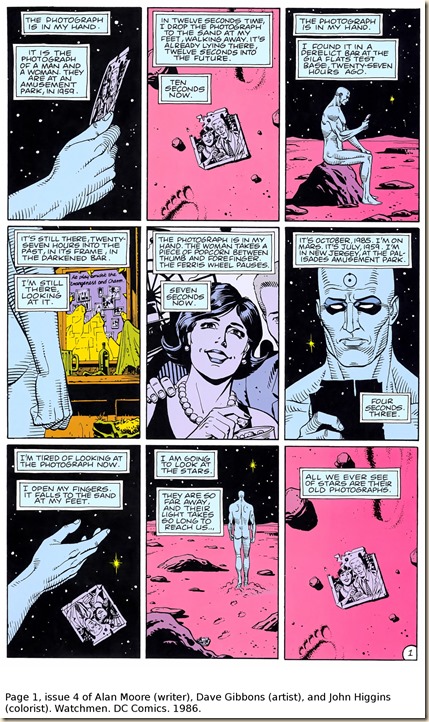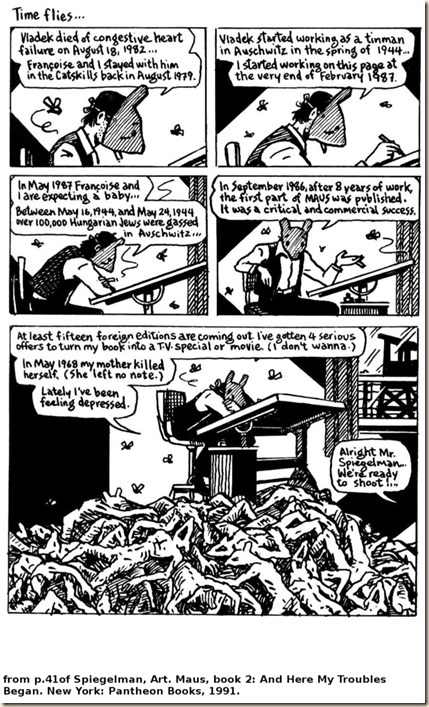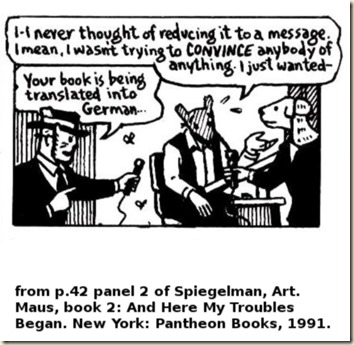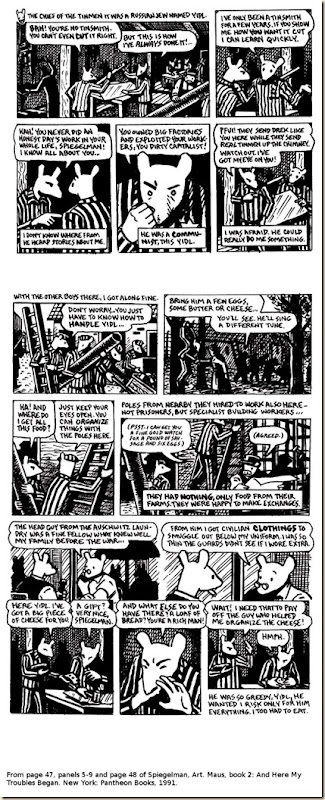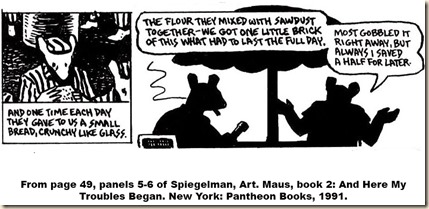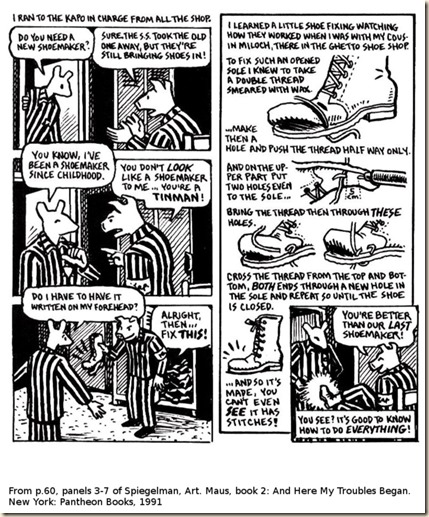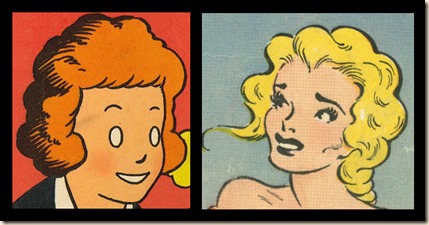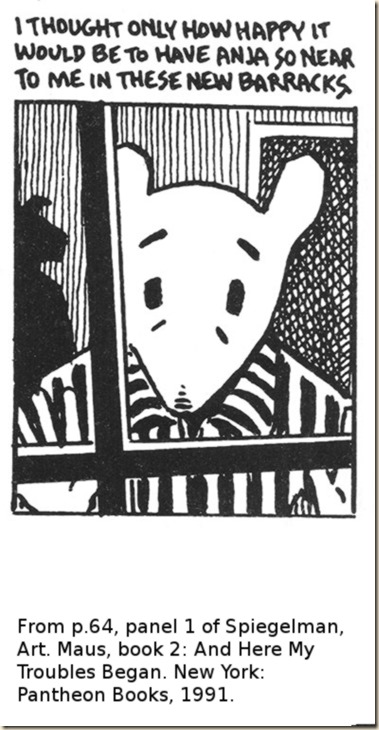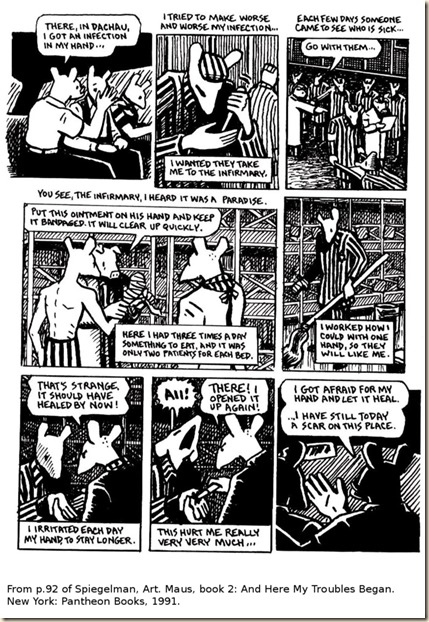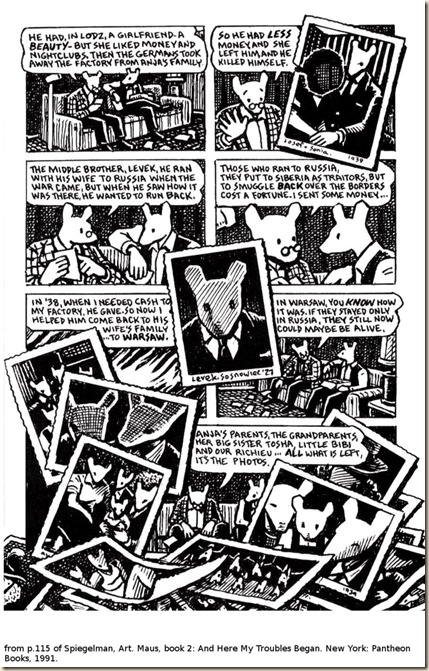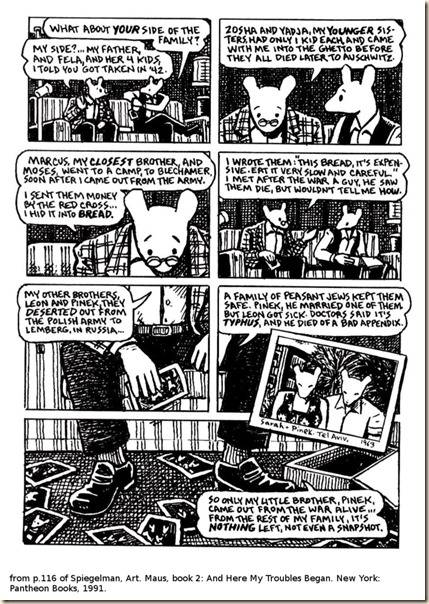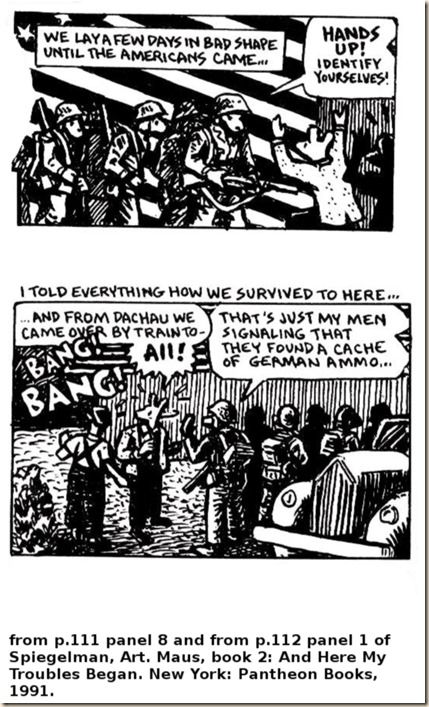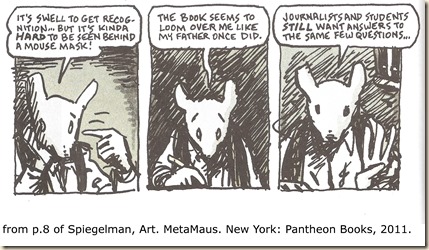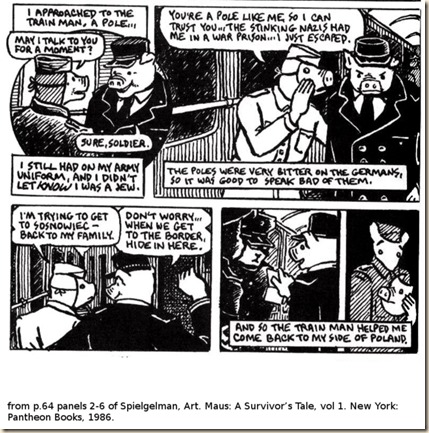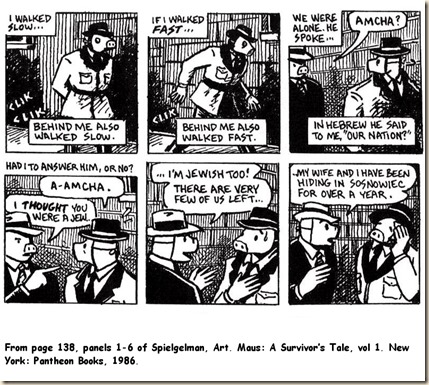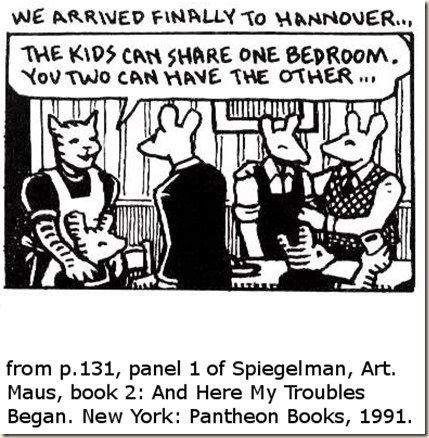MetaMaus
“Why Mice?”
Selected quotations
Hilary Chute:
“So… how did you come across the idea of drawing mice, anyway?”
Art Spiegelman:
AH, mice…
Actually, it all started with me trying to draw black folks. In 1971, when I was twenty-three, I was part of an extended community of underground comix artists centered in San Francisco, that had come together in the late ‘60s in the wake of R. Crumb’s Zap Comix. A cartoonist pal, Justin Green, was put in charge of getting together a comic book called Funny Animals. As I remember, Crumb had agreed to do the cover and lead story because Kathy Goodell, a girlfriend of his, and Terry Zwigoff (years later the director of the Crumb documentary) wanted to put out some kind of animal rights comic – you know, a mercy and respect for animals sort of thing. The tone changed as soon [111|112] as Crumb did a story about a big-legged chicken woman being stalked by two little fox boys who lure her into a bedroom and eat her. Literally.
My first thought, to do something in the mode of an old EC horror comic like Tales from the Crypt, was kind of a bust. I wanted to do something in that melodramatic pulp illustration mode, complete with venetian blind shadows, but with animal face in which the dénouement would have the protagonist getting crushed to death by a giant mousetrap that snaps shut on his body. I made some sketches but I was floundering when I went into a class that I’d been sitting in on at Harpur College (SUNY Binghamton), the school that had justifiably kicked me out a couple of years earlier (but granted me an Honorary Doctorate in 1995). A filmmaker I had become close friends with, Ken Jacobs, was teaching an introduction to cinema class. On this particular day, Ken showed a bunch of old racist animated cartoons from the silent and early sound era. The blacks were cheerfully represented as subhuman, monekylike creatures with giant minstrel lips – stereotypes stealing chickens, stealing watermelons, playing dice, all singin’ & dancin’, just the daily stock in trade of our racist cartoon heritage. In the same session he showed typical old Farmer Gray cartoons – animals frolicking on a farm, stuff like that, and I think he might have even shown “Steamboat Willie” – the first sound cartoon by Walt Disney. “Steamboat Willie” had come right in the wake of The Jazz Singer and essentially what we’re looking at here is a jazzy Mickey Mouse – not the suburban and staid Mickey Mouse of later decades. He was a jazz age wiseguy – Al Jolson with large round circles on top of his head – and it all led me to my Eureka moment: the notion that I could do a strip about the black experience in America, using an animated cartoon style. I could draw Ku Klux Katz and an underground railroad and some story about racism in America. [112|113] That seemed really exciting for a couple for days until I realized that it could be received as one more example of the trope that Crumb had consistently mined with Angelfood McSpade and other willful racist caricatures: the return of the repressed – all that insulting imagery that had been flushed out of the mainstream culture but existed in the back of everybody’s lizard brain – now brought back in a kind of Lenny Bruce “Is there any body I haven’t insulted yet?” spirit, with the hope that if you say the word “nigger” over and over again, you remove its sting. I had actually drawn some excruciatingly clumsy and embarrassing comics emulating Crumb while looking for my own voice as an underground cartoonist, and it would have been very easy for my notion to come off as one more racist “parody” even if I did bring in Ku Klux Kats and worked with honorable intent. It just felt problematic.
After my self-excoriating doubts settled in, I realized that this cat-mouse metaphor of oppression could actually apply to my more immediate experience. This development took me by surprise – my own childhood was not a subject for me. I hadn’t been thinking about that at all, and
my knowledge of what had happened in Hitler’s Germany was actually very modest – and it wasn’t clear to me then that there were echoes and precursors for this kind of imagery of Jews as vermin built into the Nazi project itself. The image of Jews as defenseless scurrying creatures was in thre somewhere – I’d read Kafka’s [113|114] “Josephine the Singer, or the Mouse Folk,” but I don’t think I’d even focused on it specifically as a metaphor for the Jewish people back then. It was just one more Kafka fable I’d absorbed. But I did realize that if I shifted from Ku Klux Kats and anthropomorphized “darkies” to the terrain I was more viscerally affected by, the Nazis chasing Jews as they had in my childhood nightmares, I was on to something. It became my three-page contribution to
Funny Animals.
Chute:
You’ve said that Hitler was your collaborator on Maus. When did you become aware of the history of anti-Semitic caricature and stereotypes in creating your animals?
Spiegelman:
I began to read what I could about the Nazi genocide, which really was very easy because there was actually rather little available in English. So I did what research I could through interlibrary loans [114|115] and remembered some anecdotes from my father’s life and began to transpose it into this animal form.
The most shockingly relevant anti-Semitic work I found was The Eternal Jew,
a 1940 German “documentary” that portrayed Jews in a ghetto swarming in tight quarters, bearded caftaned creatures, and then a cut to Jews as mice – or rather rats – swarming in a sewer, with a title card that said “Jews are the rats” or the “vermin of mankind.” This made it clear to me that this dehumanization was at the very heart of the killing project.
In fact, Zyklon B, the gas used in Auschwitz and elsewhere as the killing agent, was a pesticide manufactured to kill vermin like fleas and roaches. “Genocide” is a term that was invented after World War II to refer specifically to what had happened to the Jews because there was no label for that scale of crime: trying to kill an entire ethnic group. To accomplish that required totally dehumanizing one’s neighbors – one murders people; one commits genocide on subhumans. I remember reading that most aboriginal tribes’ name for themselves was synonymous with “the humans.” In Rwanda, for example, Hutus referred to Tutsis as cockroaches.
Dehumanization is just basic to the whole killing project – America demonized the Japanese during World War II (it’s what primed us for dropping the bomb on Hiroshima) and the Abu Ghraib torture photos suggest that the beat goes on. The idea of Jews as toxic, as disease carriers, as dangerous subhuman creatures, was a necessary prerequisite for killing my family. [115|116]
As I began to do more detailed and more finely grained research for the longer Maus project, I found how regularly Jews were represented literally as rats. Caricatures by Fips (the pen name of Philippe Rupprecht) filled the pages of Der Stürmer: a grubby, swarthy, Jewish apelike creatures in one drawing, ratlike creatures in the next. Posters of killing the vermin and making them flee were part of the overarching metaphor. It’s amazing how often the image still comes up in anti-Semitic cartoons in Arab countries today. [116. The following question on this page is skipped, along with the other material up to page 118.]
Chute:
How did you decide to draw cats specifically and create the cat/mouse metaphor?
Spiegelman:
The cats and mice just came as a set, part of all the Tom and Jerry comics and cartoons that I grew up with. One problem I had was the disparity of scale of the creatures. Tom and Jerry are not, on any level, equal. Tom looms large and even if Jerry is a smart, crafty little creature, he only comes up to the to of Tom’s paw. When I began work on the long Maus my first impulse had me drawing large cats and small mice. By the time I solved the problem to my satisfaction, I’d minimized the disparity, so that the cats and mice became, more or less, overt masks. I liked working with a metaphor that didn’t work all that well though I certainly didn’t want my metaphor to work as an endorsement of Nazi ideology, or as an implicit plea for sympathy, like, “Aw, lookit the cute defenseless little mouse.” To equalize them in scale didn’t mean to give them equal power, but it didn’t put the mice necessarily at the total biological disadvantage that the metaphor otherwise implies. In the three page “Maus” I was interested in class and racial oppression. It was my hippie self that first steered me toward the black rights thing and then eventually left me by default with the Nazi/Jew thing. What’s most curious and interesting about that first attempt is that I managed to almost totally deracinate it. The references to the Jews are as die Mausen. The references to the Nazis are as die Katzen. The factory that my father works in, in the ghetto, is not presented as a shoe factory, but as a kitty litter factory. [119|121 (only picture on p.120)] I pushed toward the metaphor of oppression, using my own history, my parents’ history, but not owning it, not trying to get the texture of the actual details right. Only when I began working on the long book did I realize that, okay, I can use my cat and mouse heads but it would be fatuous to move in the direction of Aesop’s Fables. The work would just turn fatuous and fake. Only though the specific could I imply the general. [120|121]
Chute:
How did you decide to use pigs in Maus? This particular choice has caused a lot of negative reactions?
Spiegelman:
In the first three-page “Maus,” I only needed cats and mice. Once I had to deal with, say, my father’s description of the Polish nanny that took care of Richieu… Well, what do I do with her? I couldn’t make Poles mice and I couldn’t make them cats. At that point my animated cartoon lexicon became useful. Look, Poles suffered terribly under the Nazis, but they were also often victimizers of Jews, and certainly left my father with a very, very frightened and angry response to his “fellow” Poles – anti-Semitism at that point in Polish history was rather virulent. There are still strains of it today, with almost no Jews to be virulent toward; though I hear that now Polish attitudes have begun shifting toward a kind of nostalgia, something like Americans’ attitude toward Indians as somehow exotic and admirable. In earlier centuries, the Poles were the Jews’ salvation, so I wasn’t necessarily trying to find a pejorative – but trying to find an animal outside the cat-mouse food chain, and I found Porky Pig – and the whole peaceable kingdom of funny animal comics – a useful model, since Porky’s one of the toon gang, alongside Bugs bunny and Daffy. Hey – Wilbur, the pig in Charlotte’s Web is downright endearing and pigs, in their Snowball incarnation as well as Napoleon, were the absolute stars in Animal Farm! Those dualities of piggy/swine and mousie/rodent only enrich the simplemindedness of my basic conceit in Maus.
If I think of Hitler as my collaborator, in his plan for the Thousand Year Reich, the Slavic races, including the Poles, were not meant to be exterminated like the Jews but rather worked to death. They were slated to be the master race’s work force [121|122] of slaves. In my bestiary, pigs on a farm are used for meat. You raise them, you kill them, you eat them. If you have mice or rats on the farm, there’s only one thing to do which is kill them before they eat all your grain. So my metaphor was somehow able to hold that particular vantage point while still somehow acknowledging my father’s dubious opinion of Poles as a group.
There’s one page, 138, in which the central image – the large image on the lower left – shows Vladek and Anja disguised as Poles by wearing Woolworth-like pig masks over their more convincing mouse masks. Anja’s seen with a long rat tail hanging out because it wasn’t as easy for her with her Semitic features to pass for Polish as it might have been for Vladek.
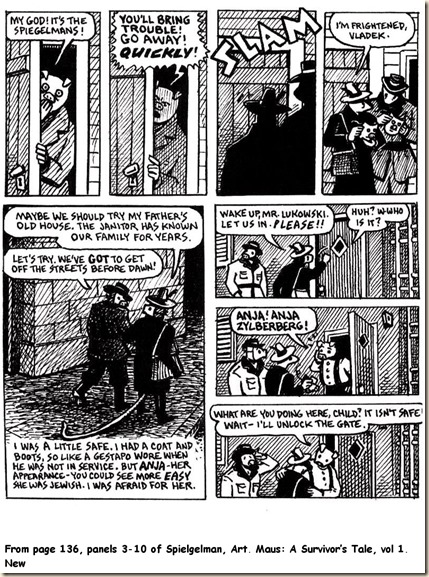
On this page, you have, essentially, a hub, which is the lower left-hand panel, and those spokes coming out, which are the surrounding material. So Vladek and Anja, in their overtly masklike masks with strings dangling in the back, are surrounded by two contrasting episodes. One has their former nanny, a Polish woman who had been an intimate of the family, opening the door when they’re seeking shelter, then slamming it on them. Later on you find out that this is the woman who basically stole whatever property they had but returned just family photos because they were of no monetary value to her or anybody else. So that’s on the one hand. On the other, on this same page, they go to see the janitor of the building they had lived in when they were well-to-do – a lower-class Polish janitor named Mr. Kukowski. In desperation they go to their old building and knock on the door and Lukowski, at great personal risk, hides them in the barn. One succinctly gets the two sides of the pig mask on one page. [122. The following skips the next question and material until p.129]
Chute:
You draw many animals in the book besides mice, cats, and pigs. how did you make those other decisions?
Spiegelman:
Well, at a certain point I did feel enslaved by my metaphor. I couldn’t just walk away and say, “So all other groups are just gonna have bland human faces, okay?” Each issue that came up required a different solution. One of the first problems was what to do about us Americans – I tend to identify myself more as an American than as a Jew – and in a melting pot like America it’s hard to know what animal one might use. Turning again to my simpleminded ur-text of American popular culture: cats chase mice, and dogs, by God, chase cats – it’s a direct food chain. In fact, using pigs specifically allowed for a creature outside that food chain, because whatever other roles the Poles had in World War II as victims and as victimizers, they also were outside the food chain. They were there as witnesses. They didn’t crate the genocide. It was taking place on their farm, you know, on their turf, and since they were not immediately slated for the same destiny as Jews, they were there as witnesses.
But dogs were easy; it’s almost the Family Feud answer to what animals come to mind and how do you perceive them. The dogs were heroic vanquisher of cats, so there was that. besides, as soon as you’re a cartoonist drawing a dog, you’ve got lots of different kinds of dogs to draw. You’ve got Collies and Dachshunds and Cocker Spaniels and Chihuahuas and their [129|130] species or sub-species are much more clearly delineated than cats, even though cat fanciers will say otherwise. Here, the fact that there were so many possible dogs got me to actually verbalize to myself: “Oh, I get it. Americans are a mongrel race, a bunch of mutts.” Bill Mauldin’s panel cartoons of Willie and Joe – the “dogfaces” of World War II as GIs were called – came to mind as soon as I started trying to figure out what it might mean to draw a dog in an army uniform.
Chute:
We have British fish, Swedish reindeer, and a lot of others…
Spiegelman:
Right. As the book was coming to a close, I really couldn’t have cared less about my metaphor, but I was stuck with it. People would ask me, “Oh, how would you draw us Italians?” and I as always stumped. I just had to deal with each of these issues as they came up, and it led to the whole sequence in Maus II of talking to Françoise about how to represent her.
In a way I started reaching for the absurd to make sure one didn’t take the ruling metaphor at, um, “face” value. When Vladek looks for Anja after the war, he goes to a large displaced persons center at Belsen. The British are in charge of that camp. I guess I could have avoided the whole issue since they just appear in the mise-en-scène for a panel or two, but I decided to give the Brits a walk-on part – or, as it finally resolved itself, a swim-on part. I thought about fish and chips, an island culture, fish out of water. All those things just seemed to lead me toward drawing fish without bicycles but with jeeps.
It echoed some panels in the first book when I first realized there are more than just Poles, Germans, and Jews in the world. When Vladek accompanies Anja to a sanatorium, there are other animals there. There was a goat, rabbits, reindeers [130|131] or moose … I don’t know, I think there was a giraffe in the background. It illustrated the possibility of that peaceable kingdom of different animals living side by side.
I vividly remember drawing the sequence where my mother went to see a fortune-teller – I was in a small cabin, deep in the woods of Connecticut that summer. I prefer to work at night when I can, and these giant moths kept flinging themselves against the glass, trying to get in. Most of them looked like casting calls for Mothra. They were insane and enormous. I got really fascinated by what their faces looked like. And it was at precisely the moment I was trying to figure out how to draw the gypsy, so it was preordained that I’d use gypsy moths.
After the war, Vladek went to Poland, and from Poland to Sweden as a displaced person with Anja. Sweden was quite welcoming to refugees after the war. I thought of the Swedes as somehow far outside the loop of my Eastern European narrative and finding an animal so totally out of the scale with mice, cats, and mutts – those large galumphing and gentle reindeer – struck me as amusing.
There’s a point in the later part of the book (page 291) where, after they are free of their captors, Vladek and his friend, Shivek, go to visit Shivek’s brother in Hannover. Vladek said that they had kids, and the brother, who is Jewish, was kept safe by his wife during the war. This was definitely a mixed marriage, so in my book that meant a cat and a mouse coupling. One of the many problems wit visualizing Hitler’s racist thinking by casting groups as different specie, is that different species cannot, of course, reproduce. In fact, Nazi propaganda often depicted the Jew as the wicked seducer of German maidenhod, defiling the Aryan race. So here a Jew and a German have kids. At first I didn’t know quite what to do, but drawing some creature that looked like something in [p131|132] between a cat and a mouse highlighted the speciousness of demarcating groups of people as separate species.
Chute:
In your article “Looney Tunes, Zionism, and the Jewish Question,” published in The Village Voice in 1989, and you bring up Sartre’s point that a Jew is someone whom others call a Jew. We see that reflected in the page where you draw a prisoner first as a mouse and then as a cat.
Spiegelman:
Yes. The racism was all so arbitrary, even the Nazis couldn’t keep it straight. In the camps, different categories of prisoners were marked with different colored triangles on their uniforms. My father told me about a German who had gotten dragged into Auschwitz as a “criminal” to be marked with a green triangle. but had somehow been classified as a Jew with a yellow triangle. My very first impulse was to avoid that anecdote – too complicated – but almost immediately I realized that it was better to race head-on into these issues of race and hierarchy. If I’d evaded the issue, one could still take comfort as a non-Jew reading Maus that it ain’t you. One of the disadvantages of using these masked figures at all is that it creates a kind of empathic response by despecifying the faces – it allows one to identify, and then get stuck with having to embrace one’s own corrupt and flawed humanity.
You’re right to spot how important that Sartre quote was to me. My own identification with my Jewishness had very little to do with religion ever since I was thirteen and went out for a slice of sausage pizza in the middle of a Yom Kippur service and wasn’t struck down by lightning. Still, I knew I would always be seen as Jewish by others, no matter what my beliefs.
Chute:
Can you say more about that? You’ve said that doing Maus made you overtly Jewish to the world.
Spiegelman:
Yes, thought it wasn’t a big secret to anyone who could read my last name. [132 |133] Doing Maus meant probing at the specific texture of the oppression directed at my own family – no more cozy liberal displacement of the discomfiting aspects of my own past onto a strip about black mice and Ku Klux Kats (though that idea keeps rattling around in my head even thirty years later).
It has become sort of a given that one of the badges of Jewish identity is pride in one’s lox and bagels, and the other given is the fact that they tried to wipe us out and, by God, it’ll never happen again! The problem for me is that I have an uncomfortable relationship with all this, because the only parts of Jewishness that I can embrace easily are the parts that are unembraceable. In other words, I am happy being a rootless cosmopolitan, alienated in most environments that I fall into. And I’m proud of being somebody who synthesized different kinds of culture – it is a fundamental aspect of the Diaspora Jew. I’m uneasy with the notion of the Jew as fighting machine, the two-fisted Israeli. I’m a wimp. But I must insist, as Woody Allen once put it, “I’m not a self-hating Jew. I just hate myself!”
Chute:
One of the most striking things about the animal metaphor is how it breaks down…
Spiegelman:
I guess it’s all an inquiry into what it means to be human in a dehumanizing world. When my father told me about his long death march out of Auschwitz near the end of the war, he describes hearing gunshots and then, at some point, he sees far ahead of him, “somebody jumping, rolling 25 or 35 times around and stops.” he tells me, “Oh, I said, they maybe killed there a dog,” because my father [133|134] hadn’t had that many experiences of seeing people shot close up, if any (although of course he did shoot someone from a distance when he was a Polish soldier). And he goes on to say, “When I was a boy, our neighbor had a dog what god mad and was biting; the neighbor came out with a rifle and shot. The dog was rolling so, around and around, kicking, before he lay quiet, and now I thought, ‘How amazing it is that a human being reacts the same like this neighbor’s dog.’”
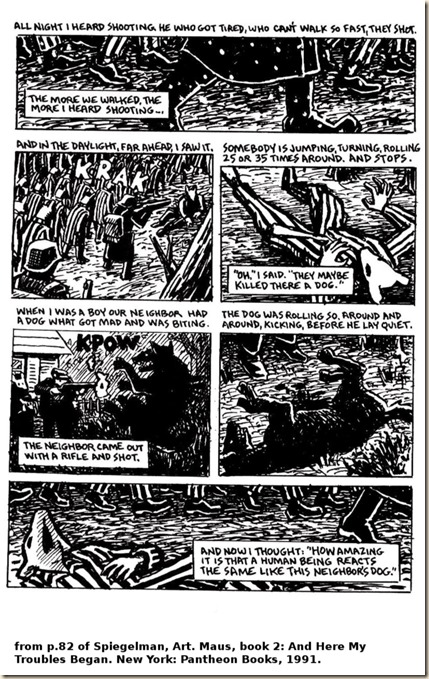
When he told me that anecdote, he certainly wasn’t thinking about me telling his story with animal surrogates – but I instantly knew this would become a key page in the story. I worked hard to make the transition between human/mouse and animal/dog as clear as I could. My father describes how “the dog rolled around and around, kicking before he lay quiet,” and that is worked out visually as a roll across the page. I didn’t try to present it cinematically, which would have been a bit corny, but I took advantage of the way the eye assimilates a page; it was analogous to showing a human rolling around, fading into a dog rolling around, and fading back into a human as it does.
Chute:
Another page where the human/animal dichotomy gets called into question is the page with the rat in the basement…
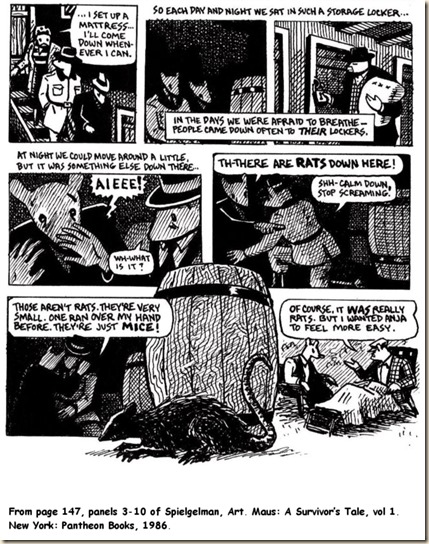

Spiegelman: Yeah, that one started as a real stumbling block. I thought, “There goes the whole ballgame.” Vladek and Anja are hiding in a basement, and they’re temporarily safe. They’re lucky to have that storage space to hide in but my mother is terrified because there are rats in the basement, and my father comforts her by telling her, “oh, they’re not rats, they’re just mice.”
My father told me this anecdote two or three times. And one of the things I kept trying to figure out was how not to queer my representational system and deal with what he was telling me. At first I assumed [134|135] I should just show him talking in the present so it wouldn’t bring “the rat thing” too much to the foreground. The fact that Vladek and Art are mice – you just don’t notice that anymore – and they’re just conversing. For a moment I figured, “Maybe I can turn the rat into cockroaches or spiders or something else lower on the evolutionary scale!” but that was totally dumb, even if it did feel like the only way to keep my conceit from collapsing.
What came to the rescue was my comic book reading as a kid, especially Carl Barks’ Donald Duck. In that whole universe of Mickey Mouse and Donald Duck comics, one is expected to embrace the ducks and Mickey Mouse as human, but accept that Mickey has a pet dog, Pluto, as well as a pal named Goofy. They’re both dogs. And it really was almost like a Zen koan for me as a kid: does a dog have a Goofy nature? And Donald Duck with his nephews, Huey, Dewey, and Louie, would go off to Grandma Duck’s farm for turkey dinner on Thanksgiving and Christmas – it was kind of horrifying to me, but a useful literary reference point when I had to solve that particular piece of my father’s story. So the whole page was build around showing as “rodentized” a rat as possible, showing Vladek and Anja on a page anchored by as unpleasant a rat as I could draw.
I should also point out that once I chose mice, I was sure that some Nazi somewhere would mutter, “Yeah, Spiegelman is just trying to whitewash the Jewish people. They’re not mice – they’re rats!” I think it’s implicit in the choices I made – like that page where Anja’s tail is so jarringly ratlike. Here’s one place where the rodent is made very clearly ratlike to call their disguise masks into question, even if you’d managed to fall into the dream state all narrative provides. [135, skipping the next question on the page and following pages up to the second question on p.145]
Chute:
You show mice with their mouths open so few times in the book. Was that deliberate?
Spiegelman:
When I show the mouths, they’re almost always there as cries and screams. It’s not usually used to show characters yukking it up and laughing really loud. It’s that triangle inverted as you look at it from underneath with a kind of scream face. It allows for a kind of vulnerability, coming in toward the underbelly of the mouse. The screaming mouth completes the face; it’s a way of making that face human.
Chute:
I was really struck when I was reading through some of your notes about Anja feeling awkward about being bald in the camps. Because none of the mice have that hair.
Spiegelman:
Yes. Although the characters don’t have their heads shaved, the effect of the almost identical mouse heads is analogous to dehumanizing prisoners by shaving their heads and rendering them anonymous, harder to recognize as individuals. [145, skipping next question and until the first question on p.148]
Chute:
What do you mean about you being the human who donned the mask in order to make the book?
Spiegelman:
It’s really implied in the first panel of the first chapter of the first volume. I had to put on a mouse head to enter into my father’s story. It was only over time that I discovered the implications of that. And I elaborated the image further as the author’s “photo” at the back of many [148|149] editions of the book. It was my intensive rethinking of how to get back into volume two, into a story that I was trying to evade – that is, how to inhabit the oxymoron of presenting life in a death camp – that made me understand I had to fully acknowledge myself as the author wresting with making a book. It became useful to indicate that, hey, you know what, there are human faces under those mouse heads, on the analyst’s couch, grappling with my father’s legacy.
Chute:
You’ve described the animals in the book as a “cipher,” and in the beginning of the first book, you even say to your father when you’re visiting him that the personal material about his life before the war makes everything more real – more human.
Spiegelman:
It was only in the course of really immersing myself in the work till it became my life that teasing out the implications became possible. This human versus mouse cipher also became an issue when dealing with my mother’s suicide. The comic I include within Maus, “Prisoner on the hell Planet,” was drawn years before, in 1972, but I knew I’d have to present the facts of my mother’s death in Maus again. I didn’t see how to enter that bit of deposition into the new bigger deposition – redraw it with mouse masks? Just offhandedly refer to the fact that Anja committed suicide and not probe what a deep scar that had made on my and on my father? Literally including the earlier piece made several things possible: having the mouse cartoonist draw this comic inside a comic with humans once again allows the central conceit to dissolve while also contrasting the emotionally-charged expressionist rendering of my own trauma with the more notational style of the larger book.
Chute:
One thing that I found fascinating about the way the book was received is this whole problem of taxonomy that has to do with drawing animals. Do the animal features disturb a kind of realist interpretation, and how have people responded to the idea of the book as nonfiction?
Spiegelman:
I was briefly considering dropping the animal thing when I started thinking about the long book, but it was so embedded in my thinking that I just couldn’t quite picture it that way, even while pursuing my parents’ story in great detail and striving for accuracy. Paradoxically, while the mice allowed for a distancing from the horrors described, they simultaneously allowed me and others to get further inside the material in a way that would have been difficult with more realistic representation, where one could constantly question my choices: “is that what that guy looked like” and you know, I actually have no idea. It gave me a certain degree of wiggle room, a certain kind of slack, about getting a detail wrong despite all my research. And I didn’t need to make up the very specific physiognomy of a specific person that I could never have known. I was doing as much research as I could, but having that mask as a prophylactic, I was able to protect myself from inaccuracies. By going back to Little Orphan Annie’s eyes – letting the reader discover the expression reading into that face, as on always does with [149|150] comics – it all actually becomes a lot more open to one’s inner sets of associations. In other words, you’ve got to do the work the same way you do when you’re reading prose, and Maus retains that attribute of prose. We’re wandering away from the issue of mice and cats here, but we are getting very close to the heart of the Maus project specifically, which had to do with a comic so heavily based on language. It’s probably part of why Maus became a crossover hit with readers uncomfortable with comics.
Chute:
Were you surprised when the New York Times Book Review put the book on the fiction side of the bestseller ledger?
Spiegelman:
It was unsettling, after having gone to such lengths to get the facts and details right. I ended up writing a letter to the Times saying, “Well, if you had a Literature and a Nonliterature section, I’d be happy with this, but fiction means made up, and that would be a whole other book than the one I’m making.” To have this testimony presented as fiction could only delight some Holocaust denier somewhere. Because I have friends who worked at the Times, I was told of a remarkable exchange that happened after the editors got my letter and were debating about whether to move my book over to the nonfiction list or not. Eventually, the powers that be decided they would; after all, Pantheon had published the book as nonfiction, and in those days that sufficed. But one editor was furious at the idea, saying, “Well look, let’s go out to Spiegelman’s house and if a giant mouse answers the door, we’ll move it to the nonfiction side of the list!”
I still puzzle over what fiction and nonfiction really are. Reality is too complex to be threaded out into the narrow channels and confines of narrative and Maus, like all other narrative work including memoir, biography, and history presented in narrative form, is streamlined and, at least on that level, a fiction. There are fictions that usefully steer you back directly to reality and fictions that beckon you off into the author’s dream life [150|151] and only reflect back onto events obliquely. I figured that Maus belonged on the nonfiction side of the Times’ system of divvying up books. Still, when Maus was offered an award by the L.A. Times for best work of fiction in 1992, my editor convinced me to shut up and accept it gratefully. [151, skipping the next question, to p.153]
Chute:
It’s surprising that there was no Maus II in Hebrew until now.
Spiegelman:
A lot of Israelis did read Maus in English. But some of the antipathy may have had something to do with the fact that the book doesn’t posit Israel as the happy ending to the Holocaust, like, say, Schindler’s List. If anything, this is a diasporist’s account of the Holocaust. But that wasn’t an ideological decision on my part – it simply had to do with the fact that my parents came to America. Had they gone to Tel Aviv instead of New York after Stockholm, it would be a very different book… probably one without pictures. I don’t know that I would have become a cartoonist there. But Israel doesn’t really figure as a factor in this story. [153|154]
I’m talking a little bit past my pay grade here, but it seems to me that the ways the Holocaust has been mythologized and used in Israel are different than the ways it gets mythologized and used in America. Perhaps it’s because I don’t show Vladek as a more heroic character, perhaps it’s because of the implied insult in using rodents for humans, perhaps it’s because Israel doesn’t figure in the work, or maybe it’s just because they have a surfeit of their own Holocaust narratives and comics have been alien to them till the day before yesterday.
One change I had to make in the first Israeli volume is worth noting. I had to agree to redraw Pesach Spiegelman’s hat as a fedora and not refer to him, as Vladek had, as a Jewish policeman on pages 121 and 126 of Maus. Though under Haskel’s protection in the ghetto, he evidently wasn’t a member of the Nazi-installed Jewish police like Haskel. Menachem, Pesach’s son (who was adopted by Haskel after they both survived the war), lives in Israel and threatened to sue the publisher for libel. Being called a Jewish policeman collaborating with the Nazis is no small change. Pesach died during the war, but only in Germany and Israel, interestingly, do libel laws extend past the grave.

So I begrudgingly changed Pesach’s hat, indicated that Pesach was Haskel’s older brother (not, as Vladek misremembered, his younger one), corrected Pesach’s wife’s name to Bluma (I had arbitrarily called her Rifka, needing a first name in one balloon), and appended an author’s note at the end of the volume summarizing Menachem’s understanding of the past, including the fact that Haskel was cleared of war crimes charges in a postwar trial in Poland. I wrote that I had made minor revisions in my art and text but found them [the following is blockquoted. Brackets around “Vladek’s” below are Spiegelman’s]
an intrusion into the process of trying to visualize and inhabit my father’s specific memory and understanding of what happened. That process is indeed the story inside of Maus… What is being portrayed is, specifically, his [Vladek’s] story, based on his memories. the kind of reconstruction is fraught with dangers. My father could only remember/understand a part of what he lived through. He could only tell a part of that. I, in turn, could only understand a part of what he was [154|155] able to tell, and could only communicate a part of that. What remains are ghosts of ghosts, standing on the fragile foundations of memory. The issue of memory is central to the sequel to Maus that I’m currently working on: From Mauswitz to the Catskills and Beyond…
I did consider incorporating my cousin’s competing memories of Haskel and Pesach into what became the second volume of Maus but just couldn’t find a way to do it. [153, Skipping next question and all the remaining ones in this chapter.]
Spiegelman, Art [with Hillary Chute (interviewer)]. MetaMaus. New York: Pantheon/Random House, 2011.





.jpeg)




































